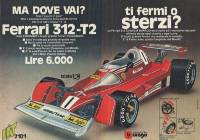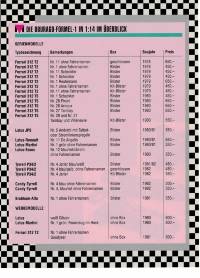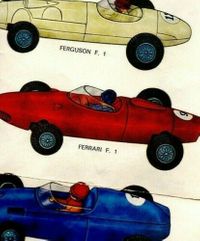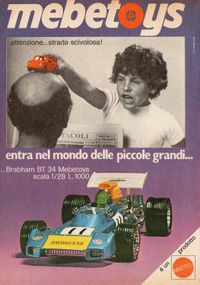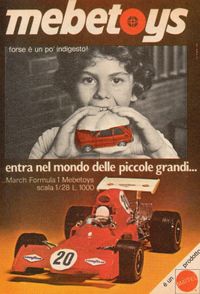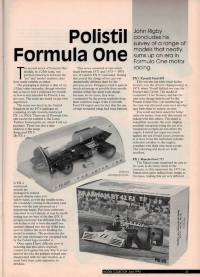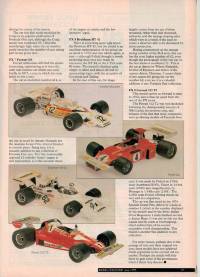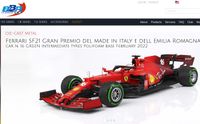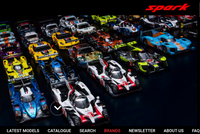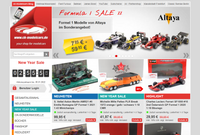Manufacturers from Italy
Barlux
Barlux was founded in 1972 in Bologna. The range of the Italians was moderate. The first Barlux models in 1:66 were called «Flash Series». The series consisted of ten Grand Prix cars: Matra MS120 (item 73001), Lotus 72 (73002), BRM (73003), Tyrrell (73004), Ferrari B2 (73005), March (73006), McLaren (73007) Brabham (73008) Surtees (73009) and Lotus Turbina (73010). About the existence of the Ferrari and the Lotus with the turbine engine I have to set a big question mark. Even in «Classic Miniature Vehicles Made in Italy» by Dr. Edward Force ten models are listed but only eight are shown. The same applies to the Barlux catalog. Also here the Ferrari and the Lotus Turbina are missing.
The models (chassis made of plastic; floor, engine and driver figure made of die-cast) are very rudimentary. But with some imagination the models are recognizable. The choice of colours differs from the original in most cases. The number on the models is often the same as the item number on the package. From this there were two variants: individually in blisterpacks or each with two models in cardboard boxes. In addition to Formula 1 models Barlux has also released the «Zoom» series with Fiat Campagnola models in 1:25. There was also a series called «Jet» with motorcycles. Around 1983 the Italians closed its doors. It is said that some moulds were later used by Jaditoys in China. The Formula 1 series from Barlux is not very rare. You can find the small cars easily on ebay or at modelcar bourses. The prices are between 5 and 10 euros. Sets with two models are a little bit more expensive.
Barlux wurde 1972 in Bologna gegründet. Das Sortiment der Italiener war überschaubar. Zu den ersten Barlux-Modellen zählten die Formelfahrzeuge der «Flash Series» im Massstab 1:66. Die Reihe bestand gemäss Verpackungsangaben aus zehn GP-Boliden: Matra MS120 (Nummer 73001), Lotus 72 (73002), BRM (73003), Tyrrell (73004), Ferrari B2 (73005), March (73006), McLaren (73007), Brabham (73008), Surtees (73009) und Lotus Turbina (73010). Über die Existenz des Ferrari und des Turbinen-Lotus muss ich ein Fragezeichen setzen. In dem sonst sehr verlässlichen Nachschlagewerk «Classic Miniature Vehicles Made in Italy» von Dr. Edward Force sind zwar zehn Modelle aufgeführt, aber auch nur acht abgebildet. Gleiches gilt für den Barlux-Katalog. Auch hier fehlen der Ferrari und der Turbinen-Lotus. Selbst eine original erstandene 48er-Packung bestand nur aus acht verschiedenen Modellen.
Die kleinen Flitzer sind aus Plastik (Chassis) und Zinkdruckguss (Boden, Motor und Fahrerfigur). Mit etwas Vorstellungskraft lassen sich die Vorbilder anhand der Proportionen erkennen. Die Wahl der Farben weicht in den meisten Fällen vom Original ab. Die Startnummer auf den Modellen ist oft mit der Artikelnummer auf der Verpackung identisch. Von dieser gab es zwei Varianten: Blisterverpackungen mit einem Modell, Kartonboxen mit zwei Modellen. Barlux hatte neben den Formel-1-Modellen auch die Serie «Zoom» mit Miniaturen des Fiat Campagnola in 1:25 im Sortiment. Ausserdem gab es eine Serie «Jet» mit Motorrädern. Um 1983 sperrten die Italiener zu. Einige Formen sollen später beim chinesischen Anbieter Jadityos wieder verwendet worden sein. Die Formel-1-Serie von Barlux ist nicht sehr rar. Man findet die Modelle immer wieder im Internet oder auf Börsen. Die Preise liegen zwischen 5 und 10 Euro. Zweiersets können etwas mehr kosten.
Bburago
Bburago is one of the most famous producer of die-cast models. Even though the company from Italy had some tough years to come through. Everything started in 1966 when Mario Besana founded a company called Mebetoys (stands for: Meccanica Besana Toys). Shortly before Mebetoys was taken over by Mattel, Besana founded another company called Martoys. Martoys was specialized in model cars made in 1:24 – until 1977. Then the company changed its name into Bburago. The new name is easily explained. It is put together from Burago, a small village close to Milano where the company was based. The second «B» in Bburago stands for its founder: Besana. Scale-wise Bburago changed its attitude and began to produce model cars in bigger scales like 1:18 and 1:14. From 1978 onwards Bburago released a series of Formula 1 cars in 1:14. These toys were prized at around 30 D-Mark. They were available as finished model or as kits.
«In the nineties the prizes for Formula 1 modelcars
in 1:14 made by Bburago literally exploded.» f1modelcars.com
It all started with the Ferrari 312 T2. Followed by the Tyrrell P34/2 sixwheeler, the Brabham BT46, the Lotus 79 and the Ferrari 312T5. The McLaren M26 with the code-number 2104 which was announced in the catalogue of 1978 never got into production. By producing different versions Bburago find a way to sell the same model several times. For example: The Ferrari 312 T5 which was driven by Gilles Villeneuve and Jody Scheckter was also released in the version of Didier Pironi, Patrick Tambay and René Arnoux, although these three guys joined Ferrari not before 1980. Same thing with the 312 T2. This car was produced in seven different versions. The black Lotus with the JPS-logos also had its revival – in green with stickers from Martini and blue in the colours of Essex. Bburago even sold the car in two different versions as a Tyrrell with logos from Candy. All in all (including promotional cars like a white Lotus with stickers from Citizen) Bburago released 25 different models in 1:14. In the nineties the prizes for those models literally exploded. Prizes up to 700 D-Mark were paid. Today the prizes are between 80 and 200 Euro.
In 1982 Bburago released the first toys of the «Grand Prix» series in 1:24. These models were not only more practical for kids due to their size. They were also half the prize of the models in 1:14. The Ferrari 126CK, the Alfa Romeo 179 and the Renault RE30 were the first three cars among this series. Like in 1:14 there are also different versions. At the beginning Bburago launched around two novelties a year. I specially liked the Brabham BT52 of nelson Piquet (world champion 1983) or the black Lotus of Ayrton Senna in JPS-design. Also the Ferrari 126C4, the Mclaren of Niki Lauda (world champion 1984) and the Williams FW08 were nice samples. Simply because of the fact that there was almost no other manufacturer for Formula 1 modelcars. From the mid-1990s on Bburago only concentrated on Ferrari. The last novelty in 1:24 for a long time was the Ferrari F300 which was driven by Michael Schumacher in 1998. After that Bburago only released formula cars from moulds which were already existing. Some of them were painted in colours of the IndyCar or Formula 3000 series. Others were completely changed into Walt Disney racers. A few years ago Bburago finally released some new Formula One models. Although the scale 1:24 is not that popular anymore like in the eighties. The important scales are today 1:18, 1:32 and 1:43.In these sizes you find a nice choice of Red Bull, Ferrari, McLaren and Mercedes.
Due to mass production and cost-effective manufacturing processes Bburago has been able to successfully compete with the Asian low-cost competitors for a long time despite its European production location. But in September 2005 Bburago had to file for bankruptcy. The foreclosure proceedings were opened on 15th October of the same year. The name Bburago has been preserved and is now as «Bburago International Ltd.» part of the Chinese May Cheong Toy Products Fty (MC Group) which also includes Maisto. Speaking of Bburago and China: Around 1996 four Formula 1 model cars made in China appeared in 1:18. Including the Benetton B188, the McLaren (called «Grand Prix»), the Ferrari 641 and the Williams FW14 (in two versions: with Camel/Nigel Mansell and Rothmans/Damon Hill). All were released by Bburago years before in 1:24. But the main company had nothing to do with these model cars. The cars were sold under the label Champion and offered in black, commercially available 1:18 boxes. The value of these rare Bburgao imitations is difficult to estimate due to lack of demand. The models were sold worldwide – from Italy to Australia.
Bburago zählt zu den bekanntesten Herstellern von Die-Cast-Modellen. Daran haben auch einige harte Jahre und ein Besitzwechsel für die Traditionsfirma aus Italien nichts geändert. Bburago-Firmengründer Mario Besana stieg 1966 mit Mebetoys (für: Meccanica Besana Toys) ins Modellautogeschäft ein (siehe Mebetoys). Bevor Besanas Konzern 1973 von Mattel übernommen wurde, gründete Besana die Firma Martoys. Diese hatte sich auf 1:24er-Miniaturen spezialisiert. Ab 1977 wurden die Martoys-Modelle in Anlehnung an den neuen Firmensitz Burago di Molgora (bei Mailand) unter der Bezeichnung Bburago verkauft, wobei das zweite «B» im Namen Bburago für Besana steht. Doch nicht nur der Name änderte sich, Bburago konzentrierte sich auch auf neue Maßstäbe – insbesondere 1:18 und 1:14. 1978 lancierten die Italiener eine Serie mit Formel-1-Autos in 1:14, die für rund 30 D-Mark als Fertigmodelle (und in einigen Fällen auch als Kit) erhältlich waren.
«In den Neuzigerjahren wurden die Formel-1-Bburagos
in 1:14 zu enormen Preisen gehandelt.» f1modelcars.com
Als Vorbilder dienten der Ferrari 312T2, der Sechsrad-Tyrrell P34/2, der Brabham BT46, der Lotus 79 und der Ferrari 312T5. Da dem Quintett ab 1981 keine Neuheiten mehr folgten (der im Bburago-Katalog von 1978 angekündigte McLaren M26 ist nie erschienen), musste sich der Sammler mit Varianten abfinden. Von denen gab es zahlreiche. So ist beispielsweise der von Gilles Villeneuve und Jody Scheckter 1980 pilotierte Ferrari 312 T5 auch mit den Schriftzügen und Startnummern von Didier Pironi, Patrick Tambay und René Arnoux erhältlich, obwohl dieses Trio erst später zu Ferrari gestossen ist. Vom Premierenmodell 312 T2 waren nicht weniger als sieben verschiedene Versionen im Handel – unterschiedliche Verpackungen mit eingeschlossen. Der schwarze JPS-Lotus wurde auch als grüner Martini, respektive blauer Essex-Lotus aus der Box geschoben. Nebenbei gab es ihn in zwei unterschiedlichen Tyrrell-Versionen mit Candy-Lackierungen. Zählt man die Werbemodelle mit (u.a. weisser Lotus mit Citizen-Werbung), sind insgesamt 25 verschiedene 1:14er-Boliden erschienen. In den Neunzigerjahren wurden die Formel-1-Bburagos heiss gehandelt. Die 1:14er wechselten auf die Überholspur und notierten Preise von bis zu 700 D-Mark! Inzwischen haben sich die Preise auf einem vernünftigen Niveau eingependelt. Für mint boxed wird zwischen 80 und 200 Euro verlangt.
1982 lancierte Bburago die Formel-Serie «Grand Prix» im Massstab 1:24. Diese Modelle waren nicht nur handlicher als die 1:14er. Sie waren auch halb so teuer. Zu den ersten Modellen gehörten der Ferrari 126CK, der Alfa Romeo 179 und der Renault RE30. Auch hier schob Bburago diverse Varianten nach. Im Schnitt erschienen zwei Neuheiten im Jahr. Besonders gelungen waren der Brabham BT52 von Nelson Piquet (Weltmeister 1983) oder der JPS-Lotus von Ayrton Senna. Aber auch der Ferrari 126C4, der Weltmeister-McLaren von Niki Lauda und der Williams FW08 waren Modelle, die zu dieser Zeit ein Lächeln auf das Gesicht eines F1-Modellautosammlers zauberten. Ganz einfach deshalb, weil es sonst keine anderen Neuheiten gab. Ab Mitte der Neunzigerjahre setzte Bburago nur noch auf Ferrari-Modelle. Der letzte Renner für lange Zeit in 1:24 war Michael Schumachers F300 von 1998. Danach gab es keine Neuheiten mehr. Stattdessen leitete Bburago aus den bestehenden Grand-Prix-Formen Fantasie-Modelle ab – teils mit Disney-Figuren, teils in Anlehnung an Lackierungen aus der Formel 3000 oder der CART-Serie. Erst in jüngster Zeit ist Bburago wieder auf den Formel-1-Zug aufgesprungen. Dabei spielt der Maßstab 1:24 bisher eher eine untergeordnete Rolle. Vielmehr sind die Größen 1:18, 1:32 und 1:43 in den Mittelpunkt gerückt. Dort gibt es inzwischen in loser Folge Modelle von Red Bull, Ferrari, McLaren und Mercedes.
Durch Maßenproduktion und kostengünstige Herstellungsverfahren konnte Bburago lange Zeit trotz europäischem Produktionsstandort erfolgreich gegen die asiatische Billigkonkurrenz bestehen. Im September 2005 musste Bburago dennoch beim zuständigen Gericht in Monza Insolvenz anmelden. Am 15. Oktober desselben Jahres wurde das Zwangsversteigerungsverfahren eröffnet. Der Name Bburago blieb erhalten und wurde als «Bburago International Ltd.» in die chinesische May Cheong Toy Products Fty. Ltd. (MC Group), zu der auch Maisto gehört, eingegliedert. Apropos Bburago und China: Um 1996 erschienen vier Formel-1-Exoten in 1:18 «Made in China». Als Vorlage dienten der Benetton B188, der McLaren (aus Lizenzgründen wie beim 1:24er-Original «Grand Prix» genannt), der Ferrari 641 und der Williams FW14 aus der Bburago 1:24er-Serie, wobei es Letzteren in zwei Versionen gab: in Camel-Farben für Nigel Mansell und in Rothmans-Lackierung mit der Startnummer von 0 von Damon Hill. Die Plagiate, angeblich unter dem Label Champion verkauft, wurden in schwarzen, handelsüblichen 1:18er-Schachteln angeboten. Der Wert dieser seltenen Bburgao-Nachahmungen ist aufgrund mangelnder Nachfrage schwer einzuschätzen. Die Modelle wurden weltweit verkauft – von Italien bis nach Australien.
Ingap
The Italian company Ingap (short form for Industria Nazionale Giocattoli Automatica Padova) has produced racing cars in plastic. The «Ingap-Series 76» which was released in 1963 includes six models in 1:41, five of them raced in Formula 1: Lotus, Cooper-Climax, Porsche, Ferrari and Ferguson P99. Compared to other manufacturers such as Isat Toys or Sam Toys the Ingap models look clumsy. The light gray tires and the oversized windshields are not very nice. Also the colours of the plastic bodies correspond only rarely to the original. The Ferrari was available in all possible colours – from blue to silver – but apparently not in red. But this problem exists also with other manufacturers of plastic toys from this time. Before Ingap produced plastic models they were strong in tin toys. Even today these models are quite rare. And not very cheap indeed. In the case of plastic miniatures the Northern Italians were not particularly fond of detail. With one exception: the Ferrari 156/63 published in 1964 with the code number 3350. This car is more than 30 cm long, has been very well done and is traded at prices in the four-digit range today. The best time of the company which was established in 1919 was shortly before World War II. Around 1938 the company founded by Mr. Casale & Co. had some 600 employees. After World War II Ingap was one of the first modelcar manufacturers to offer radio controlled modelcars. They were even quicker in its development than the Japanese. The production in Padua lasted until 1972 when Ingap merged with Eurotoys. The «76 series» was also copied by a toy manufacturer from Hong Kong. But it is unknown which company released the six Ingap-copies. One shouldn’t pay a lot for Ingap models in 1:41. But if you are interested in Ingap it is worth to have a look at the tin-toys. There are some nice pieces around.
Die Firma Ingap (von Industria Nazionale Giocattoli Automatica Padova) hat Rennwagenmodelle aus Plastik produziert. Die «Ingap-Series 76», die 1963 erschienen ist, umfasst sechs Modelle in 1:41, fünf davon aus dem GP-Sport: Lotus, Cooper-Climax, Porsche, Ferrari und Ferguson P99. Im Vergleich zu anderen Herstellern wie Isat oder Sam Toys wirken die Fahrzeuge klobig. Die hellgrauen Reifen und die überdimensional großen Windschutzscheiben gewinnen keinen Schönheitspreis. Auch die Farben der Plastikkarosserien entsprechen nur in seltenen Fällen dem Original. Den Ferrari gab es in allen möglichen Tönen, von Blau bis Silber, offenbar aber nie in Rot. Aber diese Problematik gibt es auch bei anderen Herstellern aus dieser Zeit. Ingap hatte vor diesen Plastikmodellen vor allem Blechspielzeug im Sortiment. Das lässt sich nicht nur sehen, es hat heute auch seinen (stolzen) Preis. Bei den Plastikminiaturen waren die Norditaliener nicht besonders detailverliebt. Eine Ausnahme gibt es: Der 1964 erschienene, 30 cm lange Ferrari 156/63 mit der Nr. 3350 ist sehr gut gelungen und wird heute zu Preisen im vierstelligen Bereich gehandelt. Den Höhepunkt erlebte das 1919 gegründete Unternehmen noch vor dem Zweiten Weltkrieg. Um 1938 zählte die von Mr. Casale & Co. gegründete Firma stolze 600 Angestellte. Auch nach dem Krieg machte Ingap eine Zeit lang von sich reden, als einer der ersten Modellautomanufakturen (noch vor den Japanern), die funkferngesteuerte Modelle anboten. Die Produktion in Padua dauerte bis 1972. Dann fusionierte Ingap mit der Firma Eurotoys. Die «Serie 76» existiert auch aus einer chinesischer Produktion. Welche Firma hinter den sechs Ingap-Kopien steckt, ist unbekannt. Eine Wertanlage sind die Plastikmodelle von Ingap in 1:41 auf jeden Fall nicht. Wer sich dennoch für die Norditaliener interessiert, sollte sich deren Blechspielzeug näher betrachten. Da sind ein paar teure Stücke darunter.
Isat Toys
Isat stands for «Industria Stampaggio Articoli Termoplastici» and was founded 1959 in Milan. Much is not known about the company, which has grown through the processing of plastic. The number of plastic Formula 1 models produced between 1960 and 1962 is not reliably recorded in any reference book I know. There is even not a complete overview in the «Encyclopedia Rampini» or in «Classic Miniatures Vehicles Made in Italy». It is a fact that in 1:43 the following models were available: a BRM, a Cooper, a Vanwall, a Maserati, a Mercedes W196 and a Ferrari 246 Dino. Concerning the colours: There are two versions of the Cooper – one in blue and another one in green. Also the Ferrari exists in two different colours: red and blue. The other miniatures were delivered in their original colour. In 1:66 the number of models released is even more unclear. In the reference book by Rampini there are only four models pictured: a Ferrari (625), a Maserati, a Cooper (same as in 1:43) as well as a HWM. But I also have a Mercedes W196, a BRM and a Vanwall. Both series are good quality. Especially if you consider that the models are made of plastic. Prices around 100 Euro per model are normal. The one in 1:66 are cheaper. But they are rare, too. Perhaps even a little bit harder to find because they were often lost or broken in the hands of children because of their size. In terms of packaging I only know on sort of 1:43 cardboxes. They are – like the models – quite pretty. I do not know in which form the smaller models have been sold.
Isat steht für «Industria Stampaggio Articoli Termoplastici» und wurde 1959 in Mailand gegründet. Viel ist über das Unternehmen, das durch die Verarbeitung von Kunststoff gross geworden ist, nicht bekannt. Die Zahl der zwischen 1960 und 1962 hergestellten Plastik-Formel-1-Modelle ist in keinem mir bekannten Nachschlagewerk verlässlich festgehalten. Nicht einmal in der «Encyclopedia Rampini» oder in «Classic Miniatures Vehicles Made in Italy» findet man eine komplette Übersicht. Fest steht nur, dass es in 1:43 einen BRM, einen Cooper, einen Vanwall, einen Maserati, einen Mercedes W196 und einen Ferrari 246 Dino gab. Vom Cooper sind eine blaue und eine grüne Version im Umlauf. Den Ferrari gab es in rot und blau. Die anderen Miniaturen wurden in ihrer Originalfarbe ausgeliefert. In 1:66 ist die Zahl der erschienenen Modelle noch unklarer. In Rampinis Nachschlagewerk sind ein Ferrari (625), ein Maserati und ein Cooper (dieselben wie in 1:43) sowie eine Verkleinerung des HWM abgebildet. Es gibt aber ausserdem einen Mercedes W196, einen BRM und einen Vanwall in eben diesem Westentaschenformat. Beide Serien sind qualitativ sehr hochstehend. Preise von ca. 100 Euro pro Modell keine Seltenheit. Die etwas kleineren 1:66er-Miniaturen sind etwas günstiger. Aber auch sie sind sehr rar. Vielleicht sogar noch eine Spur seltener, weil sie allein aufgrund ihrer Grösse in den Händen von Kindern schneller verloren oder kaputt gingen. In Sachen Verpackung kenne ich nur die 1:43-Kartonboxen. Die sind – wie die Modelle – sehr hübsch. In welcher Form die 1:66er-Modelle verkauft worden sind, entzieht sich meiner Kenntnis.
Mebetoys
Mebetoys stands for Meccanica Besana Toys. And was founded in 1966 by Mario Besana (see Bburago). In the catalogue from the same year the die-cast-manufacturer from Oleggio Castello near Varese also offered toy pistols and rifles alongside modelcars in 1:43. One year later Mebetoys expanded the program with irons for children. The first Formula 1 modelcar appeared in 1968. It was a Lotus Climax – in size and design nearly identical to the Penny-models by Politoys. The small racing car, die-cast in 1:66, was attached to a keychain-holder and was sold under the label «Jolly» in various colour versions. The first Formula 1 series called «Grand Prix» in 1:28 appeared in 1972. The Matra MS120 (6670) was the first of a series out of seven modelcars. It was available in blue and yellow. And was followed by the Ferrari 312 B2 (6671), the BRM P160 (6672) in three versions, the Lotus Ford 72 in Gold Leaf (6673) and JPS colours (6677), the Tyrrell-Ford by Jackie Stewart (6674), the Brabham BT34 (6675) and the March-Ford 721X (6676).
«Compared to the somewhat larger Politoys
models in 1:25 the models made by
Mebetoys were quiet simple.» f1modelcars.com
All of these die-cast-models were packaged in acryl-boxes and were offered at a price of 8.95 DM. Compared to the somewhat larger Politoys models in 1:25, which appeared almost at the same time, the models made by Mebetoys were rude. Especially the driver figures and some other plastic parts such as engine, airbox and rear wing are not very stylish. Also the tyres were not uniform in this collection. While the Ferrari was equipped with hardplastic soles, the other models were fitted with grooved rubber tyres. According to the catalogue the 1:28 series should have been continued after the first seven models. But neither the Tecno PA123 pictured on the title of the catalogue from 1973 nor the black and gold Lotus 56 with the turbine engine have ever appeared.
Officially the production of the Grand Prix series in 1:28 was stopped around 1974. Two years later Mebetoys launched the Alfa 159 from 1951. The model was part of the «Le Veterane» series with a pre-war Alfa Type P2 on his side. Already in 1969 Besanas company was inhaled by Mattel – but they kept Mebetoys as a label. Around 1983 the daughter-company of the US-toy-manufacturer established another Formula 1 series. This time in 1:25. The field consisted of an Alfa 179 (in two different colours), three Arrows A3B (with sponsor inscriptions from Warsteiner, Ragno and Golia, a candy maker from Italy), the Brabham BT49C, the Ferrari 126C2, the Ligier JS17, the Lotus 91, The Renault RE30B and the Williams FW07B. The models were offered in blue blister packaging – similar to the FG or SN series by Polistil. In 1984 the name Mebetoys finally disappeared from the scene. Some models of the 1:28 series also appeared in Argentina in the seventies. These Mebetoys imitations were produced by Gorgo. The original and the copy differ – apart from the inscription on the model base – only minimally by different stickers. Otherwise model and packaging are very similar. While the imitations from Argentina are hard to find the original Mebetoys from Italy are often seen. Prices around 30 Euro (mint boxed) are reasonable. An original key-chain-set in top condition is worth 150 Euro.
Mebetoys steht für Meccanica Besana Toys und wurde 1966 von Mario Besana (siehe Bburago) gegründet. Im Katalog aus dem selben Jahr bot der Modellautoneuling aus Oleggio Castello in der Nähe von Varese neben Pkw-Modellen in 1:43 auch Spielzeugpistolen und -gewehre an. Ein Jahr später erweiterte Mebetoys das Programm mit Kinderbügeleisen. Das erste Formel-1-Modellauto Besanas, ein Lotus-Climax in Größe und Machart identisch wie die zeitgleich von Politoys lancierten Penny-Modelle, erschien 1968. Der in 1:66 gegossene Rennwagen war an einem Schlüsselanhänger befestigt und unter dem Label «Jolly» in diversen Farbvarianten erhältlich.
«Verglichen mit den fast zeitgleich erschienen
1:25er-Modellen von Politoys sind die 1:28er von
Mebetoys punkto Details eher lieblos gestaltet.» f1modelcars.com
Die erste Formel-1-Serie, «Grand Prix» genannt, erschien 1972 in 1:28. Den Anfang machte der Matra MS120 (6670) in blau und gelb. Es folgten der Ferrari 312 B2 (6671), der BRM P160 (6672) in drei Varianten, der Lotus-Ford 72 in Gold Leaf- (6673) und JPS-Farben (6677), der Tyrrell-Ford von Jackie Stewart (6674), der Brabham BT34 (6675) und der March-Ford 721X (6676). Die Modelle wurden im Zinkdruckgussverfahren hergestellt, die meisten davon in Acryl-Schachteln verpackt und zu einem Preis von 8,95 DM angeboten. Im Vergleich zu den etwas größeren Politoys-Modellen in 1:25, die fast zur selben Zeit erschienen sind, fallen bei den Mebetoys-Miniaturen die lieblos gestalteten Fahrerfiguren sowie weitere aus Plastik gefertigte Teile wie Motor, Lufthutze und Heckflügel negativ auf. Auch die Reifen waren bei der Grand-Prix-Kollektion nicht einheitlich. Während der Ferrari mit Hartplastiksohlen ausgerüstet war, wurden den anderen Modellen gerillte Gummiwalzen aufgezogen. Laut Katalog hätte die 1:28er-Serie nach den ersten sieben Modellen fortgesetzt werden sollen. Doch weder der auf dem Titel des Katalogs von 1973 abgebildete Tecno PA123, noch der schwarz-goldene Lotus 56 mit Turbinen-Motor sind je erschienen.
Offiziell wurde die Produktion der GP-Serie in 1:28 um 1974 eingestellt. Zwei Jahre später schickte Mebetoys den Alfa 159 von 1951 ins Rennen. Das Modell verfügt über eine abnehmbare Fronthaube und ist Teil der Serie «Le Veterane», aus der auch ein Vorkriegs-Alfa vom Typ P2 stammt. Schon 1969 wurde Besanas Unternehmen von Mattel inhaliert, der Name Mebetoys aber beibehalten. Um 1983 brachte die Matteltochter – diesmal im Maßstab 1:25 – eine weitere Formel-1-Serie heraus. Das Feld bestand aus einem Alfa 179 (in zwei unterschiedlichen Lackierungen), drei Arrows A3B (mit den Sponsoraufschriften von Warsteiner, Ragno und Golia, einem Bonbonhersteller aus Italien), dem Brabham BT49C, dem Ferrari 126C2, dem Ligier JS17, dem Lotus 91, dem Renault RE30B und dem Williams FW07B. Die Modelle wurden in blauen Blister-Verpackungen angeboten – ähnlich wie die FG- respektive SN-Serie von Polistil. 1984 verschwand der Name Mebetoys endgültig von der Bildfläche. Einige Modelle der 1:28er-Serie tauchten in den Siebzigerjahren auch in Argentinien auf. Hinter den Mebetoys-Nachahmungen steckte die Firma Gorgo. Das Original und die Kopie unterscheiden sich – abgesehen von der Inschrift auf der Modellunterseite – nur minimal durch andere Aufkleber. Ansonsten sind sich Modell und Verpackung sehr ähnlich. Während die Nachahmungen aus Argentinien bei uns selten zu finden sind, trifft man die Originale aus Italien relativ häufig an. Preise um die 30 Euro (mint boxed) erachte ich als vernünftig. Ein originales Schlüsselanhängerset in Topzustand ist locker 150 Euro wert.
Politoys/Polistil
A.P.S. Politoys was founded in Milan in 1955 by Eugenio Agrati and Ennio Sala. In 1960 the company produced the first plastic miniatures in 1:41 – primarily car models based on Italian models. Between 1961 and 1965 a series of Formula 1 cars appeared – in plastic and also in 1:41 which were delivered in three stages. The first (1961) included models of the fifties. In detail: a Maserati (#52), a Vanwall (53), a Cooper 1500 (56), a Ferrari (57), a BRM (58) and a Porsche (59). The models were available in different colours; especially gray, blue and green. The proportions of the models were not quite perfect. The Cooper Norton for example, who is also part of this series but has never competed in a Formula 1 Grand Prix, is far too big compared to the massive Vanwall. The second series was launched in 1964. With cars from the early sixties like a Lola (60), a Lotus (61), an ATS (62), a HAS (63) and a Brabham (64). While the red ATS is certainly one of the most exciting models in this series, there is a question mark behind HAS. A team with this name didn’t exist in Formula 1 at the beginning of the sixties. So it can only be an invention of Politoys. In 1965 the third part of the series appeared with a second BRM (200), a Cooper (202), a Honda (203) and a Ferrari (204). A part of these Formula 1 models came out years later in Mexico under the name "McGregor". I will dedicate an own chapter to this exotic manufacturer as soon as possible under "Manufacturers – America".
From the mid-sixties on model cars by Politoys were made out of die-cast. Also the somewhat unusual scale of 1:41 was corrected into 1:43. Politoys also began to produce model cars in other scales. First of all in the matchbox size. There the Italians produced a series of so called Penny-models (in 1:66) which stood in direct competition to the Matchbox cars. On the cardboard boxes of the Penny-models there was an English coin. The series was reproduced several times by other manufacturers around the world.
A little smaller than the Penny toys were the models which were distributed in 1968 as a giveaway at BP gas stations. I can’t say how many different models of these BP cars do exist. They were available in different colours. And it is also interesting that Polistil not only produced Formula 1 cars for this BP campaign, but also at least two Formula 3 cars. Notably a Bellasi and a De Sanctis.
In 1970 there was another series of Formula 1 cars which was launched by Politoys: the series F (F stands probably for "Formula") in 1:32. The starting grid of the Italians consisted of ten models with a McLaren in two different versions: one in papaya orange, one in Yardley colours. The models were sold in transparent acrylic boxes. Because Politoys also distributed their models in the UK the company from Northern Italy got into a label-clinch with Palitoy from Leicester (founded in 1919). The two brands were confusingly similar, so the Italians changed their company name into Polistil before it became a legal matter. That also explains why the F-Series of Politoys is also available under the name Polistil. Apart from the fact that the models were re-engraved the Italians also changed the packaging. The renamed Polistil-models were sold in cardboard boxes instead of acrylic ones. They also gave the models a new series name. F became FK. Also the floor plates were changed from die-cast to plastic.The same applies to the FX series in 1:25 which was available from 1973/74 onwards. This series was also first sold in acrylic boxes under the name Politoys, before the name was changed to Polistil and cardboard boxes were used. The most interesting models in the FX series are the Brabham BT42 (FX8) and the March 721 (FX2) with the "tea tray" as a front spoiler. Part of this series was also an Indy Lotus (number FX6). Of course this is not shown here. In 1977 number FX9 appeared: the Ferrari 312T2. This late-arrival is today probably the rarest model of this otherwise quite common series.
In the mid-1970s Polistil “invented” a new scale: 1:16. In this size the Italians produced the Brabham BT44, the McLaren M23, the Ferrari 312B3, the Tyrrell P34/2, the Lotus MK3 and the Ferrari 312T2 (with four and six wheels). These models are very sought after today – especially the Ferraris. At that time Polistil was in direct competition with Bburago which Formula 1 cars were even a bit larger (1:14). The question which of them were more accurate is not easy to answer. I prefer the one of Polistil. They look a bit more realistic.
In the late 1970s and early 1980s Polistil was number one in manufacturing Formula 1 model cars. There were different series. One of them was the FG series in 1:22 (3 Ferrari, 2 Lotus, 1 Ligier with air-filled tyres). In 1:32 there was the FK series with 17 different models from ATS D1 to the Tyrrell 008. In 1:41 there was another series called CE with 17 models from the Alfa 179 to the Williams FW07. And last but not least the RJ series with model cars in in 1:55 (21 different pieces). The models of the RJ series were sold individually, as Duettos (with two models in a special packaging) or as a set with a racing transporter.
Another four models appeared in 1983 as the SN series: the Renault RE30, the Ferrari 126CK, the Ligier JS17 and the Alfa 179. Unfortunately these models were unable to match their predecessors from the FG series in terms of details. Around 1985 the last series, called RN in 1:55, appeared. It included the Brabham BT52, the Ferrari 126C3, the McLaren MP4, the Renault RE40, the Tyrrell 011 and the Williams FW08C. These models were later reissued – in the colours of AGS, Fondmetal, Lotus, Benetton, Dallara and Footwork. The latest Formula 1 innovation from Polistil, the TG series in 1:16, was made of the Ferrari 500F2, the Maserati 250F and the Mercedes W196- They were introduced in 1987.
One year later Polistil was taken over by the US toy manufacturer Tonka from Minnesota. But Tonka dropped Polistil (and production in Italy) in 1993. Shortly before the end in June 1993 a reissue of the Ferrari 312B3 in 1:16 was launched. Sources say that Polistil produced 5999 pieces of this lovely red car. The price was around 300 D-Mark. In 1994 Burgago, Polistil's longtime rival, took over the name and the remaining moulds of Polistil. In 2014 the May Cheong Group revived the name Polistil. With slot race tracks and RC models.
Polistil models are not that rare. There are always offers on Ebay or at specific auctions. Usually also for reasonable prices. The most expensive models are the one in 1:16 and the Ferrari 312 B3 which was relaunched in 1993. This model is traded for 200 to 400 Euro. Also the racing transporters, if complete, are quite interesting. Prices around 100 Euro are reasonable for a nice set.
Die Firma A.P.S. Politoys wurde 1955 von Eugenio Agrati und Ennio Sala in Mailand gegründet. 1960 begann man die ersten Plastikminiaturen im Maßstab 1:41 zu produzieren – vornehmlich Pkw-Modelle nach italienischen Vorbildern. Zwischen 1961 und 1965 erschien eine Reihe von Formelfahrzeugen ebenfalls aus Plastik und ebenfalls in 1:41, die in drei Etappen ausgeliefert wurden. Die erste (1961) umfasste Modelle der Fünfzigerjahre. Dazu gehören ein Maserati (52), ein Vanwall (53), ein Cooper 1500 (56), ein Ferrari (57), ein BRM (58) und ein Porsche (59). Die Modelle gab es in verschiedenen Farben, grau, blau und grün überwogen jedoch. Bei den Proportionen muss ein Auge zugedrückt werden. Der Cooper Norton, der ebenfalls Teil dieser Serie ist, aber nie ein F1-Rennen bestritten hat, ist im Vergleich zum bulligen Vanwall viel zu groß geraten. Die zweite Serie ließ Politoys 1964 vom Stapel. Sie befasste sich mit F1-Boliden der frühen Sechzigerjahre zu denen ein Lola (60), ein Lotus (61), ein ATS (62), ein HAS (63) und ein Brabham (64) gehörten. Während der rote ATS sicher eines der spannendsten Modelle dieser Serie ist, steht hinter HAS ein Fragezeichen. Ein Team mit diesem Namen hat es Anfang der Sechzigerjahre in der Formel 1 nicht gegeben. Es kann sich also fast nur um eine Erfindung handeln. 1965 wurde die Serie mit einem zweiten BRM (200), einem Cooper (202), einem Honda (203) und einem Ferrari (204) ergänzt. Leider hat Politoys – wie die meisten Anbieter von Plastik-Modellen – nicht immer den Originalton getroffen. Ein Teil der 1:41er-Formel-1-Modelle erlebte Jahre später in Mexiko ein Revival unter dem Namen «McGregor». Diesem exotischen Anbieter wird demnächst unter «Manufacturers – America» ein eigenes Kapitel gewidmet.
Im Hinblick auf neue Märkte rollten die Politoys-Miniaturen ab Mitte der Sechzigerjahre aus Die-Cast an den Start. Auch der etwas ungewöhnliche Maßstab wurde von 1:41 in 1:43 korrigiert. Doch Politoys hatte längst auch andere Maßstäbe ins Visier genommen. Unter anderem die Matchbox-Größe. Dort machten die Italiener den Briten mit ihren Penny-Modellen nicht nur ordentlich Konkurrenz, sie lieferten auch gleich 16 verschiedene Mini-Flitzer, die rund um den Globus diverse Nachahmer fanden. Dass Politoys ganz bewusst auf die Konkurrenz von Matchbox abzielte, lässt sich nicht nur am Namen Penny erkennen. Die Mailänder bedruckten die kleinen, blauen Kartonschachteln auch mit einer Penny-Münze.
Noch etwas kleiner als die Penny waren die Modelle, die 1968 als Werbegeschenk an BP-Tankstellen verteilt wurden. Wie viele verschiedene Modelle es in dieser Serie gab, konnte ich bis jetzt nicht definitiv festmachen. Es gab sie in verschiedenen Farben. Interessant ist auch, dass Polistil nicht nur F1-Modelle für diese BP-Aktion produzierte, sondern auch mindestens zwei Formel-3-Boliden. Namentlich ein Bellasi und ein De Sanctis.
1970 kam dann die Serie F (F steht wohl für «Formula») in 1:32 heraus. Die Startaufstellung der Italiener bestand aus zehn Modellen, wobei der McLaren in zwei verschiedenen Versionen aufgelegt wurde: einmal in papaya-orange, einmal in Yardley-Tracht. Die Modelle wurden in transparenten Acrylboxen verkauft. Durch den Vertrieb nach Großbritannien kam Politoys mit der 1919 gegründeten Firma Palitoy aus Leicester ins Gehege. Weil die beiden Marken zum Verwechseln ähnlich waren, änderten die Italiener ihren Firmennamen in Polistil, bevor es zu einem Rechtsstreit kommen konnte. Das erklärt auch, warum es die F-Serie von Politoys auch unter dem Namen Polistil gibt. Abgesehen davon, dass die Modelle neu graviert wurden, änderten die Italiener auch die Verpackungen. Neu setzten sie auf Karton statt Acryl. Außerdem gaben sie den Modellen einen neuen Serien-Name. Aus F wurde FK. Auch die Bodenplatten wurden geändert. Bei den Politoys-Modellen waren sie noch aus Die-Cast. Polistil setzte komplett auf Plastik.
Gleiches gilt für die ab 1973/1974 erhältliche FX-Serie in 1:25. Auch die wurde zuerst noch in Acrylboxen unter dem Namen Politoys verkauft, ehe man den Namen in Polistil änderte und Kartonschachteln zum Einsatz kamen. Zu den besonders interessanten Modellen der FX-Serie zählen der Brabham BT42 (FX8) und der March 721 (FX2) mit dem «Tee-Tablar» als Frontspoiler. Teil dieser Serie war auch ein Indy-Lotus (Nummer FX6). Der ist an dieser Stelle natürlich nicht abgebildet. Um 1977 erschien mit der Nummer FX9 der Ferrari 312T2. Dieser «Nachzügler» ist heute das wohl seltenste Modell dieser sonst recht häufig anzutreffenden Serie.
Mitte der Siebzigerjahre stürzte sich Polistil dann auf die Baugröße 1:16 und schickte den Brabham BT44, den McLaren M23, den Ferrari 312B3, den Tyrrell P34/2, den Lotus MK3 und den Ferrari 312T2 (mit vier und mit sechs Rädern) ins Rennen. Diese Modelle sind heute sehr gesucht – vor allem die Ferrari. Damals standen sie im direkten Wettbewerb zu den etwas größeren Bburago-Modellen. Diese waren im Massstab 1:14 gefertigt und sind – nach meinem Empfinden – nicht so präzise nachempfunden wie die Modelle von Polistil.
Ende der Siebziger-, Anfang der Achtzigerjahre festigte Polistil seine Leaderposition als F1-Modellautobauer mit den Serien FG in 1:22 (3 Ferrari, 2 Lotus, 1 Ligier mit luftgefüllten Reifen), FK in 1:32 (17 verschiedene Modelle vom ATS D1 bis zum Tyrrell 008), CE in 1:41 (17 Modelle vom Alfa 179 bis zum Williams FW07) sowie RJ in 1:55 (21 verschiedene Fahrzeuge). Wobei die Modelle der RJ-Serie einzeln, als Duettos (mit zwei Modellen in einer Spezialverpackung) oder als Set mit Renntransporter verkauft wurden.
1983 folgte ein weiteres Formel-1-Quartett, zu dem der Renault RE30, der Ferrari 126CK, der Ligier JS17 und der Alfa 179 gehören. Leider konnten die Modelle der Serie SN ihren Vorgänger aus der FG-Baureihe punkto Verarbeitung nicht das Wasser reichen. Um 1985 erschien die letzte 1:55er-Serie, genannt RN. Dazu gehörten der Brabham BT52, der Ferrari 126C3, der McLaren MP4, der Renault RE40, der Tyrrell 011 und der Williams FW08C. Diese Modelle wurden später nochmals aufgelegt – in den Farben von AGS, Fondmetal, Lotus, Benetton, Dallara und Footwork. Die letzten Formel-1-Neuheiten von Polistil, die Serie TG in 1:16 mit dem Ferrari 500F2, dem Maserati 250F und dem Mercedes W196 kam 1987 auf den Markt.
Ein Jahr später wurde Polistil vom US-Spielzeughersteller Tonka aus Minnesota übernommen. Doch Tonka ließ Polistil (und die Produktion in Italien) 1993 fallen. Kurz vor der Auflösung erschien im Juni 1993 noch eine Wiederauflage des Ferrari 312B3 in 1:16. Die Auflage soll 5999 Stück betragen haben, der Preis lag bei knapp unter 300 Mark. 1994 kaufte Bburago, der langjährige Konkurrent von Polistil, Name und Formen seines italienischen Kontrahenten auf. 2014 ließ die May Cheong Group den Namen Polistil wieder aufleben. Mit Slotrace-Bahnen und RC-Modellen.
Polistil-Modelle sind in der Regel keine Seltenheit. Auf Ebay und in Internet-Auktionen werden immer wieder originalverpackte Modelle angeboten. Für gewöhnlich auch für vernünftige Preise. Am teuersten sind die 1:16er und der 1993 nochmals aufgelegte Ferrari 312 B3. Dieser wird im Netz für 200 bis 400 Euro gehandelt. Auch die Portautos sind komplett erhalten nicht ganz günstig. Preise um die 100 Euro sind in diesem Fall sehr fair.
Sam Toys
Sam Toys began with the production of plastic modelcars in 1957. Previously the company which was founded in 1911 by Aldo Sacchi in Milano was specialized in metal processing. The Formula 1 series was one of the first in 1:43. It included a Maserati (425-1), a Vanwall (425-2) and a Ferrari (425-3) which all were released around 1958. In 1959 Sam Toys extended the program with the Mercedes W196 (426-1). The models are of a similar quality like Isat Toys but they have a working suspension which wasn’t standard in die-cast at this time. Compared to other manufacturers of plastic miniatures Sam Toys tried to be as close to the original as possible. Of course there were versions of the silver arrow in green or red but the Italians had also an original one in silver. Sam Toys also offered the four Formula 1 models in 1:87. Unfortunately I have to admit that I have never seen these models. I have to refer to the well profounded book of Dr. Edward Force «Classic Miniatures Vehicles made in Italy» where you can see the four small and obviously rare items. In addition to the racing models in 1:43 Sam Toys offered military vehicles in 1:50. In 1965 the company was shut down. Some Sam Toys models also appeared under the label «Minitoys» (until 1969). There are also those with the inscription «De Betuwe» on the bottom. I do not know the meaning. I assume that these models have been manufactured in the Netherlands or on behalf of a resident dealer. Some forms of Sam Toys also find their way to East Germany after the closure. There they were produced under the label «Espewe» until 1972. Sam Toys models are not expensive. What surprises me sometimes. After all they are of the highest quality for that time. If I would be asked to settle a prize I would suggest 50 Euro in mint boxed condition.
Sam Toys hat erst 1957 mit der Herstellung von Kunststoff-Modellautos begonnen. Davor war der 1911 von Aldo Sacchi in Mailand gegründete Betrieb auf Metallverarbeitung spezialisiert. Zu den ersten Modellen in 1:43 zählte die Formel-1-Serie mit Maserati (425-1), Vanwall (425-2) und Ferrari (425-3), die um 1958 auf den Markt kamen. 1959 erweiterte Sam Toys das Programm mit dem Mercedes W196 (426-1). Die Modelle sind von ähnlicher Qualität wie die von Isat Toys, verfügen aber über eine Federung, was zu der Zeit selbst im Die-Cast-Bereich selten anzutreffen war. Im Vergleich mit anderen Herstellern von Plastikminiaturen legte Sam Toys großen Wert auf farbliche Originaltreue. Natürlich gab es den Silberpfeil auch in grün oder rot, aber die Italiener stellten ihn auch in Silber ins Regal. Als besonderer Leckerbissen hat Sam Toys die vier F1-1:43er auch in 1:87 auf den Markt gebracht. Ich muss allerdings gestehen, dass ich die Modelle noch nie gesehen habe und berufe mich deshalb auf das Nachschlagewerk von Dr. Edward Force «Classic Miniatures Vehicles made in Italy». Dort sind die vier Mini-Rennwagen abgebildet. Neben den Rennsport-Modellen in 1:43 bot Sam Toys noch Militär-Fahrzeuge im Maßstab 1:50 an. 1965 schloss man die Tore. Einige Sam-Toys-Modelle erschienen auch unter dem Label «Minitoys» (bis 1969). Auch gibt es welche mit der Inschrift «De Betuwe» auf der Bodenplatte. Worauf sich diese Bezeichnung bezieht, kann ich nicht sagen. Anhand des Namens gehe ich davon aus, dass diese Modelle in den Niederlanden oder im Auftrag eines dort ansässigen Händlers hergestellt wurden. Einige Formen von Sam Toys wanderten nach der Schließung auch nach Ost-Deutschland. Dort wurden sie unter dem Label «Espewe» bis ca. 1972 weiter produziert. Preislich sind die Sam-Toys-Modelle keine Überflieger. Was überrascht. Schließlich sind sie von der Qualität her für die damalige Zeit absolut top. Mint boxed erachte ich Preise um die 50 Euro als absolut fair.
Yaxon
Yaxon started its production in 1978. The predecessor of this Italian company from Castelcovati was «Forma-Plast», a manufacturer that has enriched the model scene in Italy since the beginning of the seventies but has not succeeded. The range of Yaxon included three cornerstones: racing cars, tractors and bus models. In addition to sports cars Formula 1 played an important role in the range of the company from Northern Italy. The series with the numbers (0)700 to (0)714 comprised eleven Grand Prix miniatures from the period 1977 to 1980 in 1:43. As a direct competitor to Polistil Yaxon primarily used the same vehicles. For example: the Ferrari 312T2, T3 and T4 were available from both manufacturers. Same as the Ligier JS11, the Williams FW07, the Alfa Romeo 179, the Brabham BT45 and the Lotus MK3. Deviating from the range of Polistil the Wolf WR1, the McLaren M26 and the Renault RS10 have been released by Yaxon. Of the eleven models the Alfa had to serve for different versions. The modification to the Ragno-Arrows A3 driven by Siegfried Stohr is considered a rarity. Especially if you can find it in the original condition with «ARROW» sticker on the packaging. But also the modification into an Osella FA1 driven by Eddie Cheever is quite rare.
For a wider offering Yaxon painted some Formula 1 models according to IndyCar-models with stickers from STP or Budweiser. Parallel to the finished models the company from Brescia launched a series of 1:43-kits, which differ in the finish only by finer stickers. Production in Castelcovati was stopped in 1986. The remains of Yaxon have been taken over by Techno-Giodi. A Yaxon model, the Lotus MK3, emerged in the eighties in various colours in Bulgaria. The most common packaging for Yaxon Formula 1 models were the blue cardboard boxes with blister windows. The classic blister packs were somewhat rarer (but only later in the trade). As one of the first model manufacturers Yaxon also put importance on the fact that its toys have been manufactured according to international safety standards. The packaging says that the painting is «absolutely poisonfree». Because the Yaxon Grand Prix series is not very rare, the models do not achieve top prices. For «mint boxed» you should not pay more than 20 euros. Exception: The Ragno-Arrows which is actually an Alfa Romeo 179.
